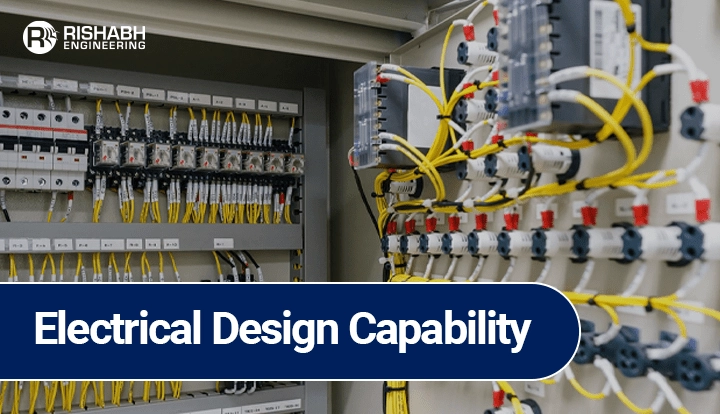
Understanding Arc Flash Study Essentials
An arc flash analysis in plant engineering helps evaluate the risk of a specific environment within a workplace to identify whether arc flash dangers are present. Employers must undertake such evaluations to guarantee that their workforce realizes the risks they face and how to protect themselves effectively. The arc flash study addresses the key question of how large the bang would be in the event of an electrical explosion. Knowing this allows businesses to appropriately safeguard their employees from the arc flash threats that exist in their workplace by providing them with the appropriate personal protective equipment (PPE).

In this blog, we’ll discuss in detail what an arc flash study is, its importance, when is it required, requirements of an arc flash study, its scope, process, and limitations, along with who can perform one to safeguard your workplace against catastrophic events.
What is an Arc Flash Study?
It is an electrical distribution system analysis that calculates the worst-case arc flash hazard that personnel could be exposed to if an arc flash event occurred. Once the Arc Flash hazard has been quantified, control measures can be implemented to mitigate it. It identifies areas of low risk and those at high risk of an arc flash incident. This allows employers to tailor their arc flash protection strategy accordingly. This study evaluates the possible severity of injury at a certain distance and determines the protection boundary at which there is a high risk of second-degree burns happening. A successful arc flash analysis has many facets, and it is generally adapted to fit a company’s specific industry and requirements. It can include arc flash calculations, comprehensive site surveys, and fault level studies.
Why is Arc Flash Study Important?
Understanding and managing arc flash dangers in electrical systems is critical for safety purposes. Rishabh Engineering, a multidisciplinary engineering team, utilizes ETAP software to conduct complete arc flash investigations, measure incident energy, and create protection boundaries. The concentrated services linked with industry standards provide bespoke solutions that optimize costs without compromising safety. We offer experienced support on everything from fault analysis to PPE recommendations. We undertake complete on-site assessments, modeling, and system evaluations in accordance with industry standards such as NFPA and IEEE. Tailored services optimize cost-effectiveness by including fault investigation, PPE recommendations, equipment labeling, and safety program development.
When Is An Arc Flash Study Required?
Arc flash studies are required by several codes, including OSHA, NFPA 70E, NFPA 70, and IEEE, with certain states in the United States, such as Washington, mandating them. OSHA’s rules regulate Employers’ safety requirements, referencing NFPA 70E. Employers must identify and protect workers against dangers in accordance with CFR Part 1910.132, backed up by documented certification. NFPA 70E establishes criteria for workplace electrical safety and mandates an overall electrical safety program. Section 130.5 requires arc flash analyses to establish incidence energy and suitable PPE. Equipment must have labels that indicate arc flash dangers, severity, boundaries, and needed PPE. These precautions help to create a safe working environment in the presence of electrical dangers.
What Are Arc Flash Study Requirements?
In a practical scenario, the requirements of an arc flash study would differ depending on the jurisdiction and the electrical system being evaluated. However, some key elements and requirements must be considered when performing such a study.
The key requirements include:
- Compliance with safety standards: Adherence to appropriate safety rules from OSHA, NFPA, and IEEE is critical.
- Comprehensive analysis entails inspecting every electrical system component, from switchgear to transformers.
- Hazard identification entails evaluating potential dangers, such as the likelihood and severity of arc flash accidents.
- Incident energy calculation: It is important to calculate the energy released during an arc flash incident at various sites across the system.
- PPE selection: It is critical to recommend proper PPE based on calculated incident energy levels.
- Protective device coordination: Ensuring the effective operation and coordination of protective equipment.
An arc flash study is essential to any electrical safety program since it protects workers from threats like electric shock. Partnering with a certified engineer or technician guarantees that the study is carried out correctly and in accordance with applicable occupational health and safety guidelines.
Who can Perform the Arc Flash Study?
Arc flash studies should only be performed by trained electrical engineers who are knowledgeable about power quality, short circuit studies, NFPA 70E, and IEEE 1584 standards. The person performing the research could be an in-house electrical expert, an external electrical engineering firm, or, ideally, a professional arc flash analysis organization. Certain processes must be performed to accurately detect and compute Arc Flash Incident Energy.
Here are some important reference points:
- IEEE 1584 provides a guide for calculating arc-flash hazards.
- IEEE Guide for Specifying Scope and Deliverable Requirements for Arc-Flash Hazard Calculation Study in Compliance with IEEE Std 1584TM.
- Practical experience.
What is the Scope of Work for an Arc Flash Analysis?
Defining the scope of work before proceeding with Arc Flash Analysis is critical. In our experience, below is a list of a few items that are in consideration:
- Customer-specific goals (system retrofit, special safety concerns, modernization, etc.)
- What section of the installation? (full system or a component only)
- System voltage can be LV, MV, or HV, with options for AC or AC&DC.
- Type of Facility (test lab, marine, data center, industrial, etc.).
- Types of DC installations include BESS, UPS, UPSaaR, DRUPS, DC motors, and DC generators.
- Operation scenarios and possible system configurations
- Related customer procedures (EHS, arc flash corporate policies).
What is the Arc Flash Analysis Process?
As a standard practice, the steps listed below enable accurate analysis and calculations. They help you detect and define Arc Flash Incident Energy and Boundary to make recommendations with improvements. While IEEE1584 and IEEE1584.1 already cover excellent recommendations, based on our experience, we have modified them slightly to demonstrate how one can effectively conduct Arc Flash Analysis in the most useful and practical manner.
7 Steps To Complete An Arc Flash Analysis
STEP 1: Acquire existing As-Built documentation
The usual starting point for an Arc Flash Analysis is to gather all the existing electrical drawings that an Owner may have. These would typically include:
- Drawings (such as floor plans)
- Riser one-line diagrams
If the documentation does not exist, electrical one-lines must be developed in the field, requiring a detailed field survey. The electrical one-line diagram is the facility’s electrical distribution road map and is a key part of an Arc Flash Analysis.
STEP 2: Field verification
It is important to field verify the drawings before loading the data from the electrical drawings into Arc Flash Analysis software like ArcSafety™, Arc Flash Evaluation, and more. Verifying one-line documentation or any other missing document is vital to generating an encompassing and accurate one-line.
STEP 3: Loading Information
After the field survey is completed and the information on the drawings is confirmed, we load it into our software program (SKM Power Tools) to perform the Short Circuit, Coordination, and Arc Flash analyses.
STEP 4: Run a Short Circuit Study
Once the data has been entered into SKM Power Tools, we compare the 3-phase and single-line to ground fault currents to the protective device’s “duty rating” to guarantee the fault can be cleared. When a fault develops at any protective device, the duty rating is the amount of fault current the device can manage and clear in what is known as a “bolted fault”. In other words, if the available fault current is less than the device’s duty rating, it will clear (as intended and constructed). If the fault currents surpass the duty rating, the device will most likely fail, resulting in an arc flash incident.
STEP 5: Selective coordination
A coordination study is then completed using the field data and SKM Power Tools. In a correctly coordinated system, the defect is cleared by the closest preventive device upstream of it without impacting protective devices farther upstream. This will limit the impact of a fault on the entire electrical distribution to the area where the issue is located.
To ensure that all current protection devices are coordinated, it is necessary to examine each device’s time vs. current characteristics and compare them to the characteristics of any upstream devices.
Proper coordination is critical for a facility. Below are examples of “poor coordination” and “improved coordination.”
- Poor Coordination: Ideally, where a fault occurs, the localized protective device should clear the fault; otherwise, the fault travels back through the system and may trip the building’s main service device, causing power loss for the entire facility.
- Improved Coordination: We can clean up the coordination issues by adjusting the settings of those protective devices that cross over on the time-current curve. The fault clears at the fault location. Adjustments we typically make on a protective device (i.e., circuit breaker with these options) include long delay, short time pickup, short time delay, and instantaneous.
STEP 6: Arc Flash Evaluation
As part of our report, we evaluate the “as is” condition of the equipment that would be considered in the study. When applicable, we recommend lowering the incident energy levels, including maximizing coordination. How do we do this? As mentioned in section 5 above, for those protective devices that can make setting adjustments, we can adjust for good coordination and lowering of “incident energy levels.” Of course, we look at coordination and arc flash energy, “incident energy,” hand in hand. Sometimes, one does not complement the other, so we must review both to maximize the best setting(s) for each.
STEP 7: System Evaluation
This marks the final step in the completion of the Arc Flash study. It would cover points as listed below:
- Generating and applying the Arc Flash labels
- Training of the electrical staff
What are the Limitations of Arc Flash Analysis?
It is particularly beneficial if the installation fits under the IEEE 1584 Model Range, which is:
- 208 to 600 volts: 500 to 106,000 amps (alternating current)
- 601V to 15000V: 200A to 65000A (AC)
Above 15kV, we will follow EPRI or ArcPro (OSHA 1910.269)-based guidelines up to 800kV system range, but supply voltages above 15kV are only used in specific situations for industrial purposes. Practical rules for Arc Flash evaluation limits from a protective device standpoint are to start at (or stop at)
- LV circuit breaker ≥63A 3P (MCB, MCCB).
- LV fuse: ≥ 100A
- LV Motors ≥ 50 HP (37kW)
- MV system up to 15kV (*>15kV EPRI/ArcPro OSHA 1910.269).
- DC systems of up to 1000VDC.
Final Words
In conclusion, conducting arc flash analysis in plant engineering is essential for assessing the potential risks within a workplace and determining the presence of arc flash dangers. An electrical engineering services company like Rishabh Engineering can help prioritize these evaluations to ensure the client’s workforce is aware of its risks and equipped with the necessary knowledge to protect itself effectively.
Businesses must adhere to the safety measures and provide appropriate personal protective equipment (PPE) to mitigate arc flash threats by addressing the crucial question of potential explosion severity. This blog has provided a comprehensive overview of arc flash studies, including their scope, process, and limitations. It emphasizes the importance of entrusting such analyses to trained electrical engineers and highlights the steps involved in completing a thorough arc flash analysis. By adhering to industry standards and conducting detailed evaluations, workplaces can safeguard against catastrophic events and prioritize the safety of their personnel.
Seek Help With Arc Flash Study & Analysis?
We conduct a thorough arc flash study & analysis while ensuring compliance and protect your workforce effectively.

